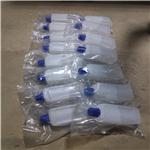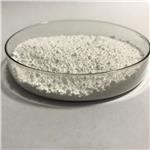Chemical Properties
Colorless liquid. Extremely reactive, can
be polymerized in liquid or vapor phase. Slightly soluble in water (0.9% by weight). Commercial
material contains inhibitor to prevent premature
polymerization. Often stored underground
to minimize vapor losses.
Uses
Copolymerization, intermediate.
Uses
Ethyl vinyl ether is used in fragrances, lubricating oil additives and spices preparation. It acts as an intermediate for sulfadiazine. It finds application in pharmaceuticals as anesthetics and analgesics. Further, it is used as a solvent in organic synthesis.
Preparation
Ethyl vinyl ether (EVE) can be prepared by reacting acetylene with absolute ethanol in the presence of an alkali catalyst. The most commonly used catalyst for vinylation is an alkali metal hydroxide or an alkali metal alkoxide.

In China, three processes for the manufacture of EVE using the acetylene route were used:
A continuous process with a homogeneous catalyst under high pressure. The advantages of this process are fast reaction rate and high conversion, but the disadvantages include the requirement of high standard equipment, large energy consumption, and easy safety issues.
A process with a solid catalyst (heterogeneous catalyst) under atmospheric pressure is relatively simple in product separation and refining compared with a process with a homogeneous catalyst under high pressure. However, it has the disadvantages of low output, the short service life of catalyst (about 110 h), and a high requirement on the specification of carrier lime.
A process with a homogeneous catalyst under atmospheric pressure has the advantages of high output and good safety but disadvantages of low conversion.
In the process with solid catalyst under atmospheric pressure, acetylene, and ethanol vapor were introduced into a fixed-bed reactor, and the vinylation reaction was carried out at a temperature as high as about 180 °C. EVE was produced with a concentration of about 70% in the outlet gas stream from the reactor. The fixed-bed reactor was charged with 4–5 mesh catalyst particles of potassium hydroxide supported on lime.
General Description
A clear colorless low-boiling liquid (35-36°C) with an ether-like odor. Flash point below -50°F. May polymerize exothermically if heated or contaminated. If polymerization takes place inside a container, the container may rupture violently. Less dense than water and slightly soluble in water. Hence floats on water. Vapors are heavier than air.
Air & Water Reactions
Highly flammable. Slightly soluble in water. Tends to form explosively unstable peroxides when exposed to oxygen.
Reactivity Profile
Ethyl vinyl ether is a very dangerous fire and explosion hazard when exposed to heat or flame. Undergoes autooxidation with formation of peroxides in the air. Can react vigorously with oxidizing materials. Undergoes explosive polymerization in contact with methanesulfonic acid [Eaton, P. E. et al., J. Org. Chem., 1972, 37, p. 1947].
Health Hazard
INHALATION OR INGESTION: Excitement followed by unconsciousness and respiratory paralysis. CNS depression. EYES: May cause irritation and transient injury to cornea. SKIN: Prolonged contact can cause tissue defatting and dehydration leading to dermatitis.
Fire Hazard
Behavior in Fire: Explosive hazard
Safety Profile
Mddly toxic by
ingestion. Mutation data reported. A skin
irritant. A very dangerous fire and explosion
hazard when exposed to heat or flame; can
react vigorously with oxidizing materials. To
fight fire, use alcohol foam, foam, CO2, dry
chemical. Explosive polymerization is
catalyzed by methane sulfonic acid. When
heated to decomposition it emits acrid
smoke and irritating fumes. See also
ETHERS.
Synthesis
Ethyl vinyl ether is synthesized by bubbling Acetylene through Ethylalcohol in presence of Sodium ethoxide.
Purification Methods
Ethyl vinyl ether (EVE) mainly contains impurities such as ethanol, acetaldehyde, and acetal and triethanolamine, which are added to prevent hydrolysis and must be refined before use. The purification is done by extensive washing with water or diluting potassium hydroxide solution. Peroxide may be generated in EVE if the latter has been stored for a long time. In this case, potassium iodide dissolved in dioxane can be applied to check if the ether contains peroxide. The peroxide in the ether can be washed by reducing agent solution of ferrous sulfate, sodium sulfite, stannous chloride, and the like, dried by potassium hydroxide and calcium chloride, and finally refined by distillation in the presence of potassium hydroxide or metallic sodium.
Purification Methods
It usually contains polymerization inhibitors (usually amines, e.g. triethanolamine) which can be removed by fractional distillation. Redistil it from sodium. [Beilstein 1 IV 2049.] LACHRYMATORY.
Toxics Screening Level
The initial threshold screening level (ITSL) for Ethyl vinyl ether is 20 μg/m3 based on an annual averaging time.








